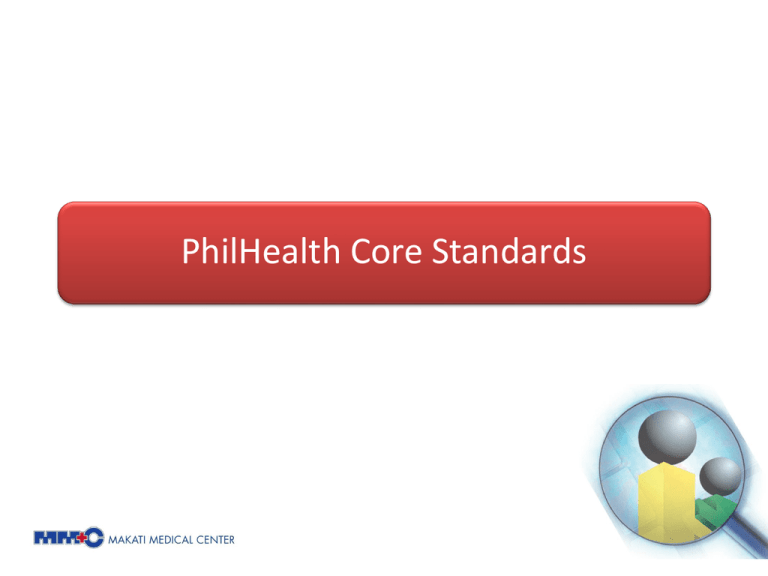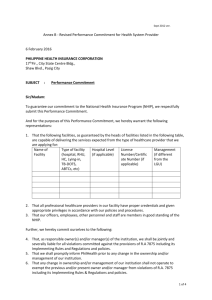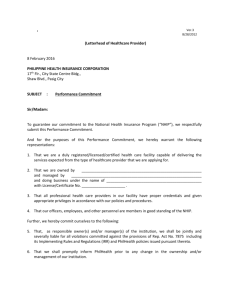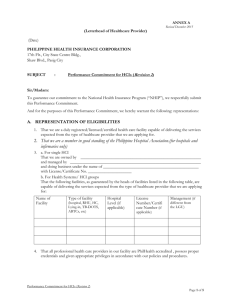Philhealth core standards_MSA
advertisement

PhilHealth Core Standards PhilHealth Benchbook • A yardstick against which the quality of health care rendered by accredited health care providers can be measured • Contains accreditation standards that evaluate processes and outcomes of health care • Represents a significant change from the current standards that govern only inputs to health care Performance Improvement Patient Rights and Safe Practice and Environment Organizational Ethics Patient Care Information management Leadership and Management Human Resources Management Element of a Performance Area Goal: Declares the overall intent of the standards under it Standard: Statement of ideal performance Criteria: Provide specific and measurable indicators that will help determine whether or not the standard has been met INDICATORS – These are tools to monitor conformance to standards with respect to specific criterion. – Performance indicators of these 79 standards have been developed by PhilHealth for your guidance. Benchbook Core Indicators • Characteristics that should be present for a hospital to function as a facility providing care, treatment and diagnosis in a manner that is safe and efficient for the patients and its staff. • Non-negotiable, absence of any of them may mean no accreditation (Linden workshop 2007) Scale for Scoring the Indicators For Core indicators • 1 = 0% compliance • 4 = 100% compliance Code Evidence SelfSurveyor Assessment score score Patient Care 2.3.2.c.1 Core Chart Review 1 1 Patient chart from medical records 4 4 Note: The progress notes should be done regularly and documented in the patient chart either as separate “progress notes” sheets or side notes in the doctor’s order sheets. Formula: Number of charts with progress notes by attending health care professional/ total number of charts reviewed x 100 Sample size: Rule of 10 Performance Area Standards (79) Criteria (141) Indicators (239) Core Indicators (51) Patient Rights 6 14 19 1 Patient Care 30 75 112 15 Leadership & Mgt 5 4 14 3 HR Mgt 8 19 27 2 Info Mgt 5 11 15 3 Safe Practice 17 16 40 25 Improving Performance 7 2 12 2 4 Things Surveyors will do: • • • • Review document – medical records Interview staff including doctors Interview patient to validate Observe patient care processes and structure Performance Improvement Patient Rights and Safe Practice and Environment Organizational Ethics Patient Care Information management Leadership and Management Human Resources Management 1. Patient Rights and Organizational Ethics Standard 1: Organizational policies and procedures respect and support patient right’s to quality care and their responsibilities in that care Criteria Indicator a. Informed consent is 1. All patient charts have obtained from patients prior to signed informed consent initiation of care 12 Examples Performance Improvement Patient Rights and Safe Practice and Environment Organizational Ethics Patient Care Information management Leadership and Management Human Resources Management 2. Patient Care Access • 2 standards, 9 criteria, 10 indicators, 4 core Entry • 5 standards, 13 criteria, 17 indicators, 1 core Assessment • 6 standards, 15 criteria, 21 indicators, 4 core Care planning • 3 standards, 6 criteria, 6 indicators Implementation of care • 7 standards, 26 criteria, 45 indicators, Evaluation of care Discharge • 3 standards, 5 criteria, 7 indicators • 4 standards, 6 indicators, 1 core 5 core 2. Patient Care • 1.Access Standard 2: Physical access to the organization and its services is facilitated and is appropriate to patients' needs. Criteria a. Entrances and exits are clearly and prominently marked, free of any obstruction and readily accessible. Indicator 1. CORE Presence of entrances and exits that are readily accessible and free from obstruction Evidence: 1. Entrance and exit signs. Check ER, OPD, wards, ICUs, OR, imaging and laboratory 2. Entrances and exits are accessible and free from any obstruction 2. Patient Care • 3. Assessment Standard 1: Each patient's physical, psychological and social status is assessed. Criteria Indicator a. An appropriately comprehensive history and physical examination is performed on every patient within 24 hours from admission. The history includes present illness, past medical, family, social and personal history. 1. CORE All patients have comprehensive history and PE within 24 hours from admission Evidence: – Patient chart from wards AND ER • NOTE: comprehensive history includes present illness, review of systems, past medical, family and personal history 2. Patient Care • 3. Assessment • Standard 2: Appropriate professionals perform coordinated and sequenced patient assessment to reduce waste and unnecessary repetition. Criteria Indicator c. Previously obtained information is 1. CORE reviewed at every stage of the All patient charts have assessment to guide future progress notes by doctors assessments Progress Notes Evidence: Patient chart from medical records Note: The progress notes should be done regularly and documented in the patient chart either as separate 'progress notes' sheets or side notes in the doctor's order sheets. • Progress notes format in: – – – – Subjective Objective Assessment Plan PROGRESS NOTES 2. Patient Care • 3. Assessment Standard 3: Assessments are performed regularly and are determined by patient's evolving response to care. Criteria d. Qualified personnel give patients for surgery pre-operative physical and pre-anesthetic assessment. Indicator 3. CORE All patients for surgery have undergone pre-operative anesthetic assessment PRE-ANESTHESIA EVALUATION FORM Evidence: – Patient chart from medical records (surgery patients) • Note: Look for preoperative anesthetic evaluation in the patient chart. Pre-operative assessment should be done for patients requiring more than local anesthesia. PRE-ANESTHESIA EVALUATION FORM 2. Patient Care • 5. Implementation of care Standard 5: Drugs are administered in a standardized and systematic manner in the provider organization. Criteria Indicator a. Drugs are administered in a 2. CORE timely, safe, appropriate and All drugs are administered in a controlled manner timely, safe, appropriate and controlled manner to the right patient Evidence: – Patient chart from the medical records • For the timeliness of drug administration, check the hospital policy. If hospital does not have policy, frequency of drug administration in the chart should be checked and validate it thru patient interview 2. Patient Care • 5. Implementation of care • Standards 2.5.5: Drugs are administered in a standardized and systematic manner in the provider organization. Criteria c. Only qualified personnel order, prescribe, prepare, dispense and administer drugs Indicator 1. CORE All doctors, nurses and pharmacists have updated licenses Evidence: – Randomly check the licenses of doctors, nurses and pharmacists if they are updated 2. Patient Care • 7. Discharge Standard 1: The discharge plan is part of the patient's care plan and is documented in the patient chart Criteria X Indicator 1. CORE All charts have discharge plans Evidence: – Patient chart from medical records, look at the discharge orders. It should contain all of the following: 1. May go home order 2. Home medications (if applicable) 3. Follow up visits/schedule 4. Home care/advise Performance Improvement Patient Rights and Safe Practice and Environment Organizational Ethics Patient Care Information management Leadership and Management Human Resources Management Performance Improvement Patient Rights and Safe Practice and Environment Organizational Ethics Patient Care Information management Leadership and Management Human Resources Management Standard 1 Planning ensures that appropriately trained and qualified (and where relevant, credentialed) staff are available to undertake the type and level of activity performed by the organization. This includes those who are consulted when suitable expertise is not available within the organization. Criteria 4.1.1.b The organization documents and follows policies and procedures for hiring, credentialing, and privileging of its staff Indicator 4.1.1.b.2 Presence of policies and procedures for credentialing and privileging of staff (CORE) Evidence • Document Review – Policies and procedures on credentialing and privileging of staff Performance Improvement Patient Rights and Safe Practice and Environment Organizational Ethics Patient Care Information management Leadership and Management Human Resources Management Information management Data collection, aggregation and use • 4 standards • 7 criteria, 8 indicators, 1 core Records Management • 1 standard • 2 criteria, 4 indicators, 1 core Information management Standard 5.1.1 Relevant, accurate, quantitative and qualitative data are collected and used in a timely and efficient manner for delivery of patient care and management of services. Criteria Indicator e. Policies and procedures on record storage, retention and disposal are documented and monitored 5.1.1.e.1 Policy on record storage, safekeeping, retention and disposal CORE Evidence • Policies and Procedures on record storage, safekeeping and maintenance, retention and disposal. For out-patients: records should be kept for 10 years after last consultation or visit Standard 5.2.1. Clinical records are readily accessible to facilitate patient care, are kept confidential and safe, and comply with all relevant statutory requirements and codes of practice Criteria Indicator b. The organization has policies and procedures, and devotes resources, including infrastructure, to protect records and patient charts against loss, destruction, tampering and unauthorized access or use. Only authorized individuals make entries in the patient chart 5.2.1.b.1 Presence of procedures to protect records and patient charts against loss, destruction, tampering and unauthorized access or use CORE Evidence • Document – Policies and procedures on records management for the entire hospital to maintain privacy, accuracy, and prevent loss and destruction • Observation – Observe nurses in the wards and records personnel on how they protect patient chart against loss, tampering, and unauthorized use Performance Improvement Patient Rights and Safe Practice and Environment Organizational Ethics Patient Care Information management Leadership and Management Human Resources Management OUTLINE 5 Sub-areas (Goals) • Standards – Criteria » Indicators 25 core indicators SAFE PRACTICE AND ENVIRONMENT Sub area Standard Criteria Indicators Core indicators Patient and Staff Safety 3 11 17 10 Maintenance of the Environment of Care 4 - 5 3 Infection Control 5 4 10 9 Equipment and Supplies 3 1 3 1 2 - 3 2 Energy and Waste Management 6.1 Patient and staff safety Standard 3: The organization routinely collects and evaluates information to improve the safety and adequacy of the environment of care Criteria Indicator b. An incident reporting system identifies potential harms, evaluates causal and contributing factors for the necessary corrective and preventive action 1. Presence of incident reporting system/sentinel event monitoring system (CORE) Evidence Incident/ sentinel event reports or communications/memoranda/orders/proceedings on sentinel events Interview: How the incident reporting system works? PhilHealth Definition of SENTINEL EVENT • Refers to injuries caused by medical management (and not necessarily the disease process) that either caused death, prolonged hospitalization or produced a disability during the time of confinement or by the time of discharge. Incident Reporting System Adverse events occurrence report to TQS within 24-48 hours root cause analyses / structure, process & system review monitor improvement make necessary changes Incidences Transfusion reactions Complications during moderate or deep sedation and anesthesia use Security incidences Adverse drug events Falls (patients/visitors /employees) Complications during invasive or non-invasive procedures (diagnostic or therapeutic) Medication errors Needlestick injuries Any undesirable or potentially dangerous occurrence in the hospital 6.3 Infection Control Standard 5: When needed, the organization reports information about infections to personnel and public health agencies 1. Policies and procedures on reporting of infections to public health agencies -- through Infection Prevention and Control Office 6.3 Infection Control Communicable diseases (34) reportable to Makati Health Department ASAP or within 5 days of diagnosis: Chlamydia H. Influenza Mumps Cholera Hepatitis A, B, or C Pertussis Conjuctivitis HIV/AIDS Poliomyelitis Dengue Fever Influenza Rabies Diphtheria Legionella Roseola E.Coli (enterohemorrhagic) Leprosy Rubella Chickenpox Encephalitis Leptospirosis Salmonellosis / shigellosis Streptococcal (Inv) disease Enteric / Typhoid / paratyphoid fever Malaria Measles Meningitis Syphilis Tetanus Toxic shock syndrome Gonorrhea Meningococcal disease Tuberculosis 6.5 Energy and Waste Management Standard 2: The organization implements a waste disposal program which involves reuse, reduction and recycling Indicator Evidence (Core) 1. DOCUMENT Memos, guidelines on waste disposal Contracts with waste handlers Hospital policy INTERVIEW on: SOPs on waste disposal OBSERVATION Segregation of waste Proper labeling of receptacles Recyclable waste staging areas Proper management of temporary storage areas prior to hauling for disposal Proof of implementation of policies and procedures on waste disposal PROPER WASTE & SHARPS DISPOSAL Health Care Waste Management Manual Department of Health Color-coding for Waste Segregation: METRO MANILA ORDINANCE No. 16: regulation of hospital waste disposal in Metro Manila • • • • • • Black Green Yellow Orange Red/Lavander Clear Plastic BLACK (Non-infectious Dry Waste) • Paper & paper products (used paper, paper cups, tetra packs, boxes) • Bottles (glass & plastic) • Packaging materials (styropore, aluminum, plastic, candy/food wrapper) GREEN (Non-infectious Wet Waste) • • • • • Kitchen left-over food Used cooking oil Fish entrails, scales & fins Fruits & vegetable peelings Non-infectious left-over foods YELLOW (Infectious & Pathological Waste) • Gauze, swabs, cotton soaked in blood/body fluids from wound dressings, immunization, Pap smear, etc. • Foreign bodies removed from body parts • Placenta, umbilical cord ORANGE (Radioactive/Nuclear Waste) 1125 (Iodine 125) H3-Thymidine Cesium –137 Things contaminated with these radioactive materials (gloves, tissue papers, swabs, gauze, test tubes, syringes, etc.) • Used x-ray films, developers, fixers • • • • RED / Lavander hazardous waste –cytotoxic/ antineoplastic agents or drugs used for cancer chemoRx, vials & bottles containing such agents –solusets & IV tubing's used for their infusion –Insecticides –used batteries Clear Plastic Bags • All other vials & used I.V. bottles Performance Improvement Patient Rights and Safe Practice and Environment Organizational Ethics Patient Care Information management Leadership and Management Human Resources Management 7. Improving Performance Code 7.1.x.1 core Standards The organization has a planned systematic organization- wide approach to process design and performance measurement, assessment and improvement. Indicator Evidence - Policy creating the QI Presence of Quality Improvement Program program - Proof of meetings or similar documents of QA Committee activities - Policies and procedures on performance measurement and improvement - Validation of QI activities thru interview of pertinent staff including front liners and Committee members 7. Improving Performance Code 7.6.x.1 core Standards The organization provides better care service as a result of continuous quality improvement activities. Indicator Presence of patient satisfaction survey Evidence - Patient satisfaction survey results - Patient satisfaction survey questionnaire Accreditation Award (Subject to Approval of PhilHealth President) Center of Safety Compliance to 100% of CORE indicators AND 60% Compliance to each of the following: •Patient’s Rights and Organizational Ethics, •Safe Practice and Environment •Patient Care Center of Quality Compliance to 100% of CORE indicators AND 75% Compliance to each of the following: •3 performance areas above •Information Management •Human Resource Management •Leadership and Management Center of Excellence Compliance to 100% of CORE indicators AND 90% Compliance to each of the 7 performance areas Accreditation Awards Provisional Accreditation (subject to PhilHealth President’s approval) • • • 50-59% safety standards AND at least 70% of core indicators – Plan for attainment of those indicators incldg target time of achievement – Temporary plan/action to address the gap – Monitoring of PhROs – Results at the end of timetable, subject to validation of PhilHealth 6 months to comply










